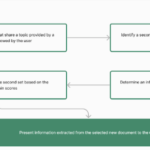This week’s Ask An SEO question comes from Carrazana in Cuba, who asks:
“How do you find the right, long-tail keywords for articles? I can not find the right keywords and long tail keywords for my post and articles. I use keywords everywhere.”
Great question, Carrazana! Lots of content professionals struggle with finding long tail keywords, and many worry about cross-over between posts, also known as keyword and topic cannibalization.
The way to find long tail keywords and prevent cannibalization is to change your mindset on needing keywords by article and incorporate non-traditional research tools. So, let’s solve this so it is no longer an obstacle for you.
I’m going to start by addressing cannibalization, then jump into using non-traditional keyword research methods like LinkedIn hashtags and strategies our agency uses to generate ideas for our clients.
One thing I’d like to emphasize is to not focus on keywords; focus on the topic, and providing the best possible user experience for the intent of the topic.
Cannibalization
Instead of thinking about the keywords that are needed, think about the topic that you’re writing for.
The same words and phrases could mean different things and have different intent based on the topic, even if they’re used in the same way. Not in the sense of a homonym or double entendre, but as in search intent.
The same phrase for the service should exist in multiple pages of content, including product or service pages for conversions, and in guides to help consumers learn more, decide where to purchase, or how to prepare. The difference here is the topic changes based on the intent.
On the conversion page, the phrase needs to reinforce that this is a page that the consumer can take action on. For a how-to guide, it is more informative and should help the consumer know how to do it themselves, prepare for the professional to come and visit, or learn how to hire the right person for the job.
Search engines are smart enough to know the intent of content and can show it as needed. This is why you want to have a clear intent when creating content.
If you sell apples, do not define what an apple is on your product or service page.
The person already knows; instead, define it on a blog post about “what an apple is.” The product or service page should be about the benefits of using the specific apple, like baking, eating it directly, or feeding it to specific animals as a treat.
Your blog posts can include definitions, guides, and comparisons of which apples are better for specific purposes and why, as well as other non-conversion-oriented content.
Both the product page and at least one guide will have “apples for horses,” but the intent is different.
One page clearly shows where you can buy an apple to feed a horse, while the other explains why that particular apple is better for horses, which may be its nutritional value or the way a horse’s tastebuds and body respond to the sugar or fiber content.
I’m making this up for the example; don’t take it as factual advice. You can deploy schema to let the search engines know when to show each page based on search intent.
Product and service schema goes on the pages where you want conversions, and article or blog posting schema can go on the guides and informative ones. The machine learning portions of the search engine will look at the associations around the text while other aspects read the schema to determine what the purpose of the page is.
Proper implementation and clear wording make the search engine’s job easy and reduce the chance of cannibalization. Now that you know how to prevent cannibalization, let’s go into finding long tail keyword topics.
Finding Long-Tail Keyword Phrases
Finding long-tail keyword phrases is simple when you step outside of the normal tool sets. You have data points your competitors and third parties don’t have access to using customer data, and there are non-traditional places you can search.
Customer Support
Start by reading customer service and live chat transcripts. See if you can extract questions that mention specific products or services or by a category like blue t-shirts or red apples. With this information, you can see the words and language your customers are using, and how frequently.
These become long tail phrases for content on all forms of pages. You can also see the questions they have, reasons they return product, and recommendations customer support offers to guide them to the correct option to purchase.
These data points lead to sizing guides and comparison shopping content, articles about one fabric being better than another for a purpose like cocktail parties or running a marathon, and answer questions for the shopping and checkout process.
You may also find that these are questions being asked about your competitors like which of their models is similar to a specific product on your website.
You can create solutions on your site to bring in this type of traffic by answering their customers’ questions and optimizing your site for them via search.
LinkedIn, Pinterest, Instagram, And Other Hashtag Sites
Social media sites that power part of their search and algorithm with hashtags are a goldmine of topics.
Go to LinkedIn and click on a hashtag like #SEO or #business. You’ll see how many people subscribe to it, how often it is used, and engagement on new content published within the hashtag’s feed.
If the hashtag is being used regularly and has engagement, look at the posts that exist within it. By knowing which gets the most comments, activity, and other signals, you can use them as a basis for new content on your own website.
As a bonus, they can be shared on these social platforms and hopefully get social media engagement too.
Bonus tip: The most engaged may only be engaged because the person or company that shared has an active following. Look for three that are similar in topic and see if two of the three have engagement to determine if it has the potential for a bit of virality on social media.
Forums And Q&A Sites
Next, use forums and question-and-answer sites. Take a Reddit forum and plug it into an SEO tool like Semrush, Ahrefs, or Moz to see the keywords and phrases they’re ranking for.
You may find a lot of long tail that could be relevant to your own product or service offerings.
Then look at the specific threads showing up for these phrases and see if there are new long-tail keyword phrases being used by the community. This gives you insight into their mindset – compare it with your own live chat and customer service data.
Q&A Keyword Tools
There are some great tools out there to find long-tail phrases, like AlsoAsked.com and AnswerThePublic.com. When you type a keyword phrase in you can see the ideas these tools come up with for topics to write about and the keywords the tools feel are related to the main topic.
Use Autocomplete On YouTube And Search Engines
The last tip is to use auto-complete on search engines, including YouTube. Once on YouTube, type in a portion of a phrase or a keyword and you’ll see it begin to autofill potential matches.
When there’s one that is relevant for your audience, click it and then look at the titles and descriptions from each video.
Many creators use chapters, and these chapters are what the content creator found to be helpful and relevant to the phrase. Each can become topics and phrases for you as well. Next, watch each video, listen to the wording and phrases the YouTuber uses, and read the comments section below.
You’ll learn the questions that weren’t answered in the video, the jargon users use, and find more content ideas as well as gaps you can fill in to bring new information into the mix. This same strategy applies to TikTok, Instagram Reels, and other video content platforms.
There’s no shortage of ways to find long-tail keyword phrases; the only limit is your own creativity.
As a content writer and SEO professional, you have tons of it! I hope this post helps you find more to write about.
More resources:
Featured Image: Paulo Bobita/Search Engine Journal



















